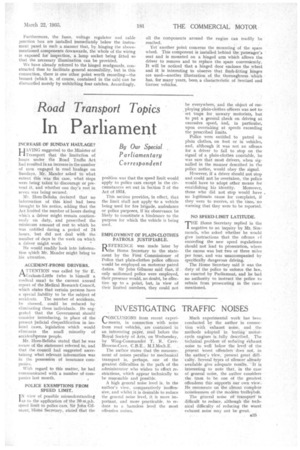INVESTIGATING TRAFFIC NOISES
Page 49

If you've noticed an error in this article please click here to report it so we can fix it.
CONCLUSIONS from recent experiments, in connection with noise from road vehicles, are contained in an interesting paper, readbefore the Royal Society of Arts, on Wednesday, by Wing-Commander T. R. CaveBrowne-Cave, C.B.E.,
The author states that the measurement of noises peculiar to: mechanical transport is, perhaps, one of the greatest difficulties in the path of the administrator who wishes to effect restrictions, which appear technically to be reasonable and possible.
A high general noise level is, in the author's view, comparatively inoffensive, and whilst it is desirable to reduce the general noise level, it is more important, and more practicable, to reduce to a harmless level the most offensive noises.
Much experimental work has been conducted by the author in connection with exhaust noise, and the methods adopted' in testing " motorcycle engines is fully described. The technical problem -of reducing exhaust noise to well below the level of the preaent worst offenders does not, in the autho{'s view, present great difficulty. Several types of silencer' already available give adequate results. It is interesting to note that, in the case of general noise, the author considers the tram to be one of the greatest offenders; this supports our own triew. He comments. on the alrhost cOinplete noiselessness of -the modern trollesibik The general noise oftransportis difficult to reduce, although the technical difficulty of reducing the worst exhaust noise may not be great—




























































































